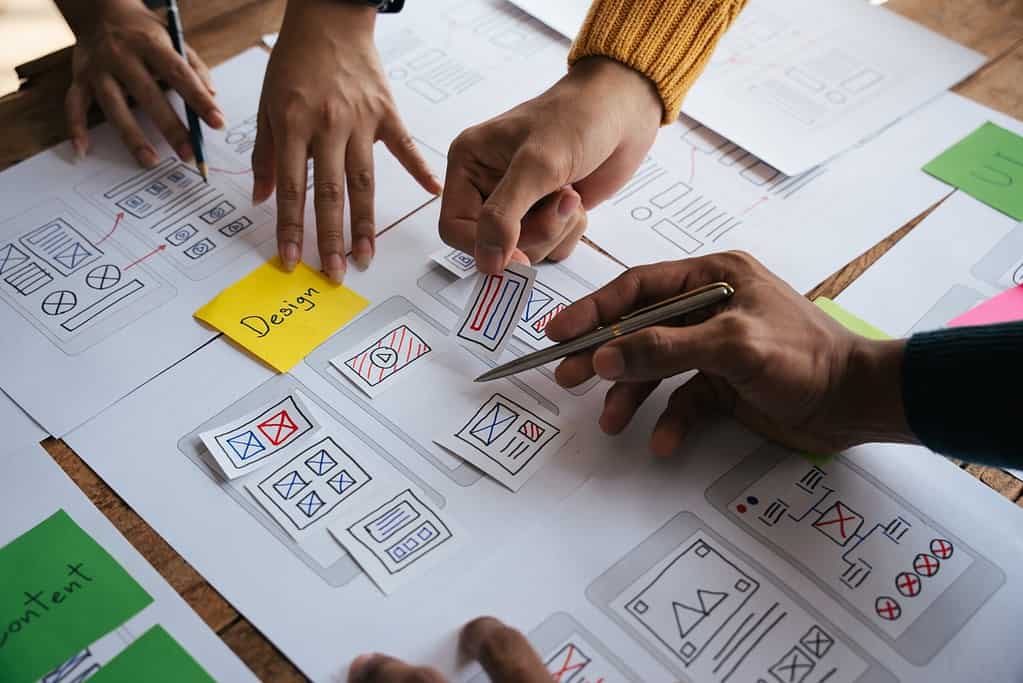
Key Points
- Design thinking is an approach centered on the customer, first and foremost.
- It is a collaborative approach that invites people to get creative.
- Proper implementation of the approach can see massive returns on your investment.
Is your company leveraging design thinking? There are several different approaches to accomplishing a project or delivering a new product. For some organizations, implementing Lean principles and frequent Kaizen events is the way to go. For others, it might require a comprehensive overhaul of their organization to embrace TQM.
Design thinking is similar in scope to these approaches. Today, we will take a deep look at what design thinking is, how it works, and some of the best examples of an organization using it. Who knows, your organization might benefit from implementing it.
What Is Design Thinking?

If you’re new to the concept, design thinking is a customer-centric method for designing new products or improving current ones. It uses data to place the customer’s needs first and foremost. Where this approach differs from something like Lean Six Sigma by leveraging data to create the solution first, rather than trying to solve the problem.
This leads to far more focus on effective solutions instead of remediation for existing problems in a production pipeline. Consider for a moment trying to promote a new worker’s training initiative at work. You’ve got an issue with engagement, your employees are simply not going for it when they should.
Now, most approaches would focus on ways to increase worker engagement by looking at the circumstances leading to a lack of engagement. Design thinking would have the team go to the mat to figure out a way to engage the employees effectively without considering potential problems.
The 5 Phases of Design Thinking
At its core, you can distill design thinking into five separate phases. These are similar in scope and execution to DMAIC or other approaches. The four phases of design thinking encourage the team behind it to consider the customer, empathize with them, and ultimately make decisions based on the impact they have on said customer.
With that in mind, let’s explore the four phases a little more in-depth and how they are executed during the planning stage. Keep in mind that many different models of design thinking exist in the world, with some having as few as 3 phases and some having as many as 7 phases.
Empathize
The first phase of any design thinking project is going to consider the end user first and foremost. At its core, any business is centered around its customers. While we often like to think we have our customers’ best interests in mind, that might not always be the case. The first phase hones in on the customer, and more specifically their needs.
This can be done in a few different ways, but having data on hand is a huge help. You don’t necessarily need hard numbers to get things done, but even just opinions from customer surveys go a long way. One big thing I need to emphasize here is not to make assumptions based on current trends.
The world is ever-changing, and customer needs today might not be the same in a week. As such, having actionable information that informs your decision-making process is going to go a long way. This is arguably the most important of the phases, as your entire decision-making apparatus is built around customer expectations.
Clarify

Now that you’ve identified your customer needs, it is time to apply that knowledge to your goal. How do you go about this though? With most problem-solving initiatives, you’d take the time to draft a problem statement or brief to go through your next steps.
The overall concept doesn’t necessarily change just because you’re implementing design thinking. You’re still taking the time to outline the current issues but with actionable information on hand regarding the subject.
Consider all potential areas that could cause a problem, but keep in mind the impact they have on your customers. Further, you can implement this phase during your customer surveying, asking specific questions about the end product or service.
Ideate
You’ve got your problem statement drafted with your customer needs in mind. Now, the next step in the process is brainstorming solutions. Now, this isn’t an uncommon phase in most problem-solving frameworks. You’re going to spend time bouncing ideas around in a team to more readily understand and solve a problem.
However, where you’ll want to expend great effort in the Ideate phase is to simply take the time to consider the impact any potential solutions are going to have on your customers. Further, this is the prime time to openly communicate and collaborate. Design thinking isn’t a solo project by any means.
As such, don’t be afraid to get creative and out there. Consider the strengths and weaknesses of your team and how you can develop sound concepts that are going to lead to an effective implementation of your solution.
Develop
The Develop phase can have separate stages, but the core concept remains the same. At the end of the day, you’re going through multiple prototypes or iterations to get your concept ready for prime time. Remember, this isn’t about nailing the solution out of the gate but doing viable testing to see what sticks and what doesn’t.
During the Develop phase, you’ll want to take the time to ask hard questions to determine if something is worth iterating upon over and over again. This isn’t about perfection, but rather seeing what works best in your workflow.
Implement
The final phase is to simply implement these solutions and test their viability. This is a natural extension of the Design phase, and might have to call back to it a few times before the best solution is derived. This is all about testing, getting user feedback, and going back to the drawing board if something simply doesn’t work.
Examples of Design Thinking In Use
We’ve taken the time to expound upon what design thinking is and how it functions, now it’s time to take a moment and look at some real-world examples of it in action. A few of the services and products shown are software-based and for good reasons.
The software development pipeline of many firms is tailored around rapid and gradual changes. You can think of something like Agile or DevOps with a continuous testing pipeline as a form of design thinking tailored specifically around digital deliverables.
Airbnb
This organization has made a big splash in the last half a decade or so. In reality, the core concept has been around for much longer, with the company starting in 2008. However, the company’s flagging fortunes saw it embracing design thinking in a big way.
Rather than focusing simply on stays, Airbnb implemented design thinking to consider its customers’ needs. This led to a complete overhaul of the service, with better images, detailed information, and a streamlined checkout process. The proof is in the pudding, as Airbnb is a veritable giant in its. space.
Uber Eats

Love or hate food delivery services, they’ve arguably changed the culture around eating. Uber Eats was developed with design thinking in mind, taking the hard lessons learned from its rideshare counterpart into consideration.
As such, Uber set out to figure out a way to tailor the food delivery experience around every metropolitan area it services. Customer needs vary geographically, especially with something as subjective as taste in food.
Oral-B
Oral-B is a recent adherent to design thinking, especially in the arena of electric toothbrushes. Originally, their next-generation toothbrush was going to center around user data, giving end users metrics on brushing habits and how well they’re getting their teeth cleaned. This ultimately proved to be a dead-end.
Instead, Oral-B shifted gears and looked at ways to increase user engagement. They made it so it was easy as can be to order replacement heads while making the charging process streamlined. The results fared far better than the ill-reviewed early implementation of their previous concept.
PillPack
One area where customers struggle is with prescriptions. As we get older, the list of required medications can sometimes grow. This leads to a great deal of confusion for users who are ordering multiple prescriptions at a time. PillPack sprung up with design thinking at the front of its core philosophy.
PillPack lists all prescriptions on the package and sorts them out into doses. It has changed the way many are engaging with their prescriptions.
IBM
Computing giant IBM is arguably one of the greatest success stories in design thinking. It has maintained an internal design thinking team for nearly a decade now and has seen a massive return on that investment. IBM is a storied company, with a history going back well over a century.
This adoption of the methodology has seen massive returns and has greatly reduced expenses and development time needed for new solutions to be delivered.
Bank of America

From my time in tech, I can flatly tell you most financial institutions are resistant to change. When you consider how many older banks are still running software from the 1970s and 1980s, it can seem almost surprising to see one embracing modernity.
Bank of America has been implementing design thinking for nearly 20 years now, using the methodology to increase engagement and get new accounts opened.
Netflix
When I think of a true Cinderella story for design thinking, Netflix is at the top of the list. The company has its roots in when video rental was still a very real thing for most customers. Rather than forcing users to head to a brick-and-mortar location, Netflix simplified the process and had users select their movies and have them delivered by mail.
This has changed in modern times, as video rental stores have gone by the wayside. Netflix continues to embrace design thinking in adapting to these changes, being one of the leading streaming companies on the market today.
Other Useful Tools and Concepts
Looking for some other tools and concepts to supercharge your business? You might do well to learn how fishbone diagrams work for problem-solving. This is one of the most basic tools at your disposal, and also one of the most effective for finding potential root causes.
Additionally, you might want to take a closer look at how artificial intelligence is impacting Lean Six Sigma projects. This exciting new technology is changing the way businesses operate, and our comprehensive article on the subject can get you up to speed.
Conclusion
Design thinking puts the customer first, as do many of the concepts we cover here. However, you might do well to implement it in your design or problem-solving cycles. By going through a cycle of constant prototyping and revision, you’re honing in on what your customers are after.